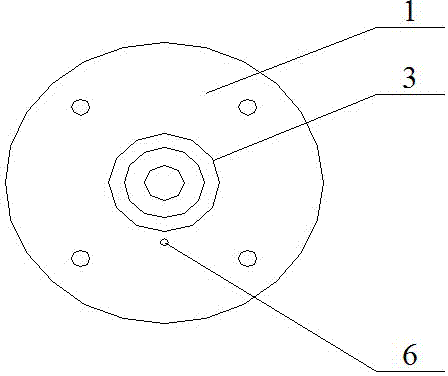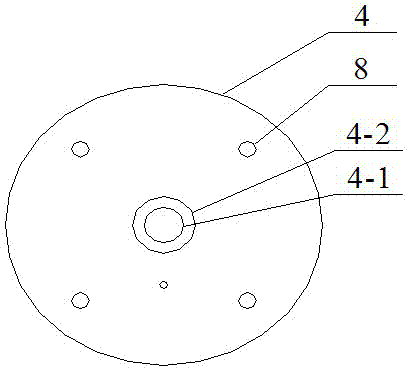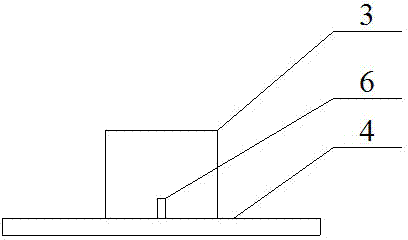Electrochemistry detection cell
A detection cell and electrochemical technology, applied in the field of electrochemistry, can solve the problems of a large amount of detection reagents, unsuitable for sheet electrodes, inconvenient use, etc., and achieve the effects of good application prospects, simple and exquisite design, and less consumption.
- Summary
- Abstract
- Description
- Claims
- Application Information
AI Technical Summary
Problems solved by technology
Method used
Image
Examples
specific Embodiment approach 1
[0015] Specific implementation mode one: as Figure 1~6 As shown, the detection cell in this embodiment includes two parts: a cell body 1 and a bottom 2 . The pool body 1 is a cavity composed of a cylindrical pool 3 and a disc base 4 concentrically. The upper part of the side wall of the cylindrical pool 3 is provided with a fine hole 5, and the disc base 4 is provided with a copper column 6. The disc base is connected with the pool bottom 2 by screws.
[0016] In this embodiment, the material of the detection cell may be a polymer material such as polymethyl methacrylate (PMMA), polytetrafluoroethylene or the like.
[0017] In this embodiment, the inner diameter of the cylindrical pool 3 is 1-1.5 cm, the outer diameter is 1.4-1.9 cm, and the height is 2-4 cm.
[0018] In this embodiment, the disc base 4 has a thickness of 0.3-0.8 cm and an outer diameter of 4-5 cm.
[0019] In this embodiment, the size of the pool bottom 2 is the same as that of the disc base 4 , but the a...
specific Embodiment approach 2
[0021] Embodiment 2: This embodiment differs from Embodiment 1 in that the inner diameter of the cylindrical pool 3 is 1 cm, the outer diameter is 1.4 cm, and the height is 2.5 cm. The disc base 4 is 0.5 cm thick and has a diameter of 4 cm. Four screw holes 7 are evenly distributed around the disc base 4 for combining the cell body 1 with the bottom 2 of the detection cell. The bottom 2 is a disc with an outer diameter of 4 cm and a thickness of 5 mm. The electrodes to be used are sandwiched between the cell body 1 and the bottom 2 of the detection cell. There is an elastic copper column 6 (diameter 0.1 cm) on the disc base 4 at a distance of 0.3 cm from the cylindrical pool 3, and the copper column 6 is used to combine with the sheet electrode. There is a fine hole 5 with an inner diameter of 0.1 cm at a distance of 0.3 cm from the top of the cylindrical liquid reservoir 3, and the fine hole 5 is used for inserting the platinum wire counter electrode into the detection cell....
PUM
| Property | Measurement | Unit |
|---|---|---|
| thickness | aaaaa | aaaaa |
| thickness | aaaaa | aaaaa |
| diameter | aaaaa | aaaaa |
Abstract
Description
Claims
Application Information
 Login to View More
Login to View More - R&D
- Intellectual Property
- Life Sciences
- Materials
- Tech Scout
- Unparalleled Data Quality
- Higher Quality Content
- 60% Fewer Hallucinations
Browse by: Latest US Patents, China's latest patents, Technical Efficacy Thesaurus, Application Domain, Technology Topic, Popular Technical Reports.
© 2025 PatSnap. All rights reserved.Legal|Privacy policy|Modern Slavery Act Transparency Statement|Sitemap|About US| Contact US: help@patsnap.com



